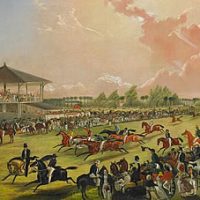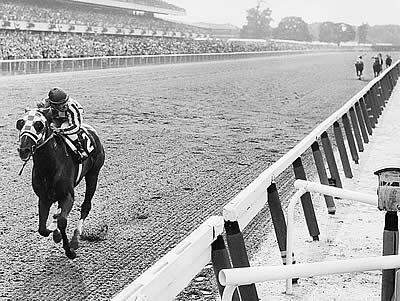Horse racing in the United States dates back to 1665, which saw the establishment of the Newmarket course in Salisbury, New York, a section of what is now known as the Hempstead Plains of Long Island, New York. The American Stud Book was started in 1868, prompting the beginning of organized horse racing in the United States.
Bookmaking, the process of taking bets, calculating odds, and paying out winnings, was banned in the early 20th century, but pari-mutuel betting, introduced in 1908, restarted the racing industry. Free live horse race video streaming of all horse and greyhound races across the world is available using the BetAmerica promo code. BetAmerica will give you content that is gathered from the thoroughbred, quarter horse, harness horse, and greyhound tracks from across the county – all major race courses, so you don’t miss a race.
The traditional high point of thoroughbred US horse racing is the Kentucky Derby, held on the first Saturday of May at Churchill Downs in Louisville, Kentucky. Together, the Derby, the Preakness Stakes, held two weeks later at Pimlico Race Course in Baltimore, Maryland, and the Belmont Stakes, held three weeks after the Preakness at Belmont Park on Long Island, form the Triple Crown of Thoroughbred Racing for three-year-olds. They are all held early in the year, throughout May and the beginning of June.
The Breeders’ Cup event is held in late October or early November at different race tracks every year. It receives less attention than the Triple Crown series from the general public but is of great importance in determining the American Horse of the Year and annual Eclipse Award divisional winners. It is normally held at a different track every year, though some racetracks have held back-to-back renewals. It currently consists of thirteen races held over two days with total prize-money of $28 million.
In 1665, the first racetrack was constructed on Long Island. It is the oldest Thoroughbred race in North America. The American Stud Book was started in 1868, prompting the beginning of organized horse racing in the United States. There were 314 tracks operating in the United States by 1890, and in 1894, the American Jockey Club was formed.

Quarter horse racing began in 1674 in Henrico County, Virginia. Each race consisted of only two horses and they raced down the village streets and lanes. The Quarter Horse received its name due to the length of the race as the races were indeed a quarter of a mile, or 400 meters. The breed of horse was developed so they could get off to a quick start and win the race.
There are also a Triple Crown of Harness Racing for Pacers and a Triple Crown of Harness Racing for Trotters, as well as an Arabian Triple Crown consisting of Drinkers of the Wind Derby in California, the Texas Six Shooter Stakes, the Bob Magness Derby in Delaware. Also, the main Standardbred event is the Breeders’ Crown.
American Thoroughbred races are run at a wide variety of distances, most commonly from 5 to 12 furlongs (0.63 to 1.50 mi). The shorter distances are more common but the mid-to-long distance races tend to be higher in prestige. Breeders of Thoroughbred race horses attempt to breed horses that excel at a particular distance.
The American Quarter Horse was not recognized as an official breed until the formation of the American Quarter Horse Association in 1940. In order to be successful in racing, Quarter Horses need to be able to propel themselves forward at extremely fast sprinter speed. The Quarter Horse has larger hind limb muscle and have more Type II-b fibers, which allow the Quarter Horse to accelerate rapidly. With the exception of the longer, 870-yard (800 m) distance contests, Quarter Horse races are run flat out, with the horses running at top speed for the duration.
Harness racing is a form of horse racing in which the horses race at a specific gait (a trot or a pace) and are pulling a two-wheeled cart called a sulky, occupied by a driver. In North America, harness races are restricted to Standardbred horses.
Standardbreds are so named because in the early years of the Standardbred stud book, only horses who could trot or pace a mile in a standard time (or whose progeny could do so) of no more than 2 minutes, 30 seconds were admitted to the book. The horses have proportionally shorter legs than Thoroughbreds, and longer bodies. Standardbreds generally have a more placid disposition, due to the admixture of non-Thoroughbred blood in the breed.
Races can be conducted in two differing gaits – trotting and pacing. The difference is that a trotter moves its legs forward in diagonal pairs (right front and left hind, then left front and right hind striking the ground simultaneously), whereas a pacer moves its legs laterally (right front and right hind together, then left front and left hind).
Almost all North American races are at a distance of one mile. North American harness horses earn a “mark” (a record), which is their fastest winning time at that distance. Harness races involve a good deal of strategy.
Important annual races include the Hambletonian for 3-year-old trotters, the Little Brown Jug for 3-year-old pacers, and the Breeders Crown series of twelve races covering each of the traditional categories of age, gait, and sex. The Hambletonian is part of the Triple Crown of Harness Racing for Trotters and the Little Brown Jug is part of the Triple Crown of Harness Racing for Pacers.
